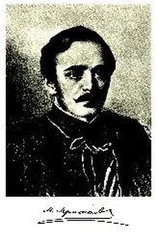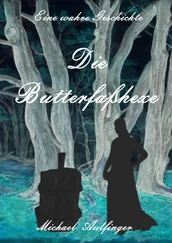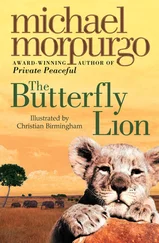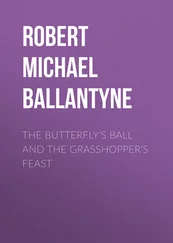The following morning the valley below our camp and a significant sward of savannah looked as if they had been decorated for the senior-class prom. Flowers boogalooed in the breeze, flipping scarlet petticoats and saffron capes. To walk through those dancing flowers would have been akin to shuffling through a post-party spill of perfumed crepe paper. I drank the scene in. It intoxicated me, but not in the way that puckerplums could do. I still had my basic motor skills, and with these intact I led Helen down the ridge from our camp into the holiday ground cover—into, it seemed, a garden.
We were not alone in this celebration, for the other Minids also came cavorting down the slope.
Experimentally uprooting handfuls of scarlet or lavender, the children went sniffing from blossom to blossom, much in the way that kids in Florida frolic in the virgin white graupel of a rare February sleetfall.
Groucho, Bonzo, Jocelyn, and Pebbles stayed the longest of all the habiline youngsters, but Helen and I outlasted even them, and when they had finally departed, we collapsed panting amid the luxuriant vegetable filigree of our narrow mountain valley.
Below, on the revivified pasturage of the plain, elephants, zebras, gazelles, and lanky giraffids grazed, but Helen and I ignored them in beatific contemplation of each other’s navels.
Literally.
I saw that Helen’s abdomen had taken on the contour, if not the coloring, of a cantaloupe. Astonished, I touched her taut tumescent tummy and searched her eyes for some sign that she understood the significance of this alteration in her figure. In the land of the lean of loin, the pot-bellied person is… well, pregnant.
“Helen, you’re going to be a mamma. A mamma, do you understand? Hell, I don’t understand—but it’s terrific, it’s great!”
“ Mai mwah,” she replied, plucking a violet blossom between forefinger and crippled-looking thumb.
* * *
Pregnant? My Helen, pregnant? Once over my initial lethargic surprise, I accepted Helen’s pregnancy as natural, foreordained, and welcome. But surely a human-habiline union could not be fruitful because of a basic chromosomal incompatibility between our two species. Even with males of her own kind Helen had heretofore been barren.
How, then, had I overcome these formidable obstacles to getting her with child ?
I do not really know. Much of what occurred during this period had the lazy inevitability of events in a vision or a fugue. Today, though, I can emphasize that barren does not necessarily mean sterile ; it first implies the absence of offspring and only secondarily the inability to conceive them. Until she actually delivers a child, therefore, it is by no means incorrect to call a woman barren. Misleading, perhaps, but not incorrect.
Why did Helen not conceive a child by Alfie or one of the other male habilines, then?
Not being a gynecologist, a fertility researcher, or a certified expert in habiline insemination techniques, I must again confess ignorance. The most ingenious explanation I can hazard suggests that, genotypically, Helen was a forerunner of a hominid species closely resembling H. sapiens . Because her reproductive organs reposed farther forward than was usual among the females of her kind, she may have appeared too early to exploit this latent genetic potential—except, of course, by accident. I was Helen’s accident, an unforeseeable throwback from the future already encoded in her DNA. For which reason she conceived my child rather than Alfie’s, Malcolm’s, Roosevelt’s, or anyone else’s.
But members of distinct species—even within the same genus—are seldom interfertile.
Well, how often do they get a chance to be?
Still, it is said that apes and humans cannot profitably mate.
Profit is not always the primary motive in such encounters. Does this epigram constitute a statement of empirical fact, a pending piece of Natural Law, or an ethical imperative? None of the above, I’m afraid.
Moreover, the expression “cannot profitably mate” runs headlong into the highly suggestive fact that a siamang and a gibbon of another species confined together several years ago at Atlanta’s Yerkes Primate Center surprised their keepers with a cuddly wee one. Admittedly, neither a siamang nor its gibbony lover is a human being, but by the same token the lady I called Helen Habiline was not an ape . That simple truth bears reiteration.
Now, years later, I have the words of the following unimpeachable scientific authorities, whom I cite to intimidate the untutored:
Eugene Marais, South African naturalist and primatologist: “I am strongly inclined to believe that the offspring of no two sub-races of the same anthropoid will be found to be sterile.” (Some of the terminology may be dated, but the sentiment is unequivocal.)
Carl Sagan, American astronomer and poet laureate of scientific syncretism: “For all we know, occasional viable crosses between humans and chimpanzees are possible. The natural experiment must have been tried very infrequently, at least recently.” (One can only speculate about the biological consequences of the liaison so discreetly chronicled in John Collier’s His Monkey Wife .)
Donald Johanson, American paleoanthropologist and discoverer of the fossil remains of the Australopithecus afarensis specimen known as Lucy: “It would be interesting to know if a modern man and a million-year-old Homo erectus woman could together produce a fertile child. The strong hunch is that they could; such evolution as has taken place is probably not of the kind that would prevent a successful mating.” (However, one might reasonably suppose that a million-year-old woman had long since passed through menopause.)
Of late it has been fashionable for critics to dismiss my claim as a contemptible form of sexual braggadocio. I refute this mean-spirited charge by confessing my inadequacies as a lover.
First, a quotation from the pens of Richard Leakey (Blair’s Kenyan nemesis) and Roger Lewin (erstwhile editor of New Scientist ): “As a biological response to female sexuality, human males have evolved a penis that is larger than any other primate, including the gorilla whose body bulk is almost three times that of a man’s.”
Sic, sic, sic.
(A connoisseur of others’ slip-ups and solecisms, Blair once hung a sampler bearing this remarkable assertion on the wall of his private office in the National Museum in Marakoi.) Despite an indefatigable popular belief in the sexual prowess of males of my pigmentation, my penis is not as large as a gorilla. It is not even as large as an Airedale. It may be as large as a lesser mouse lemur, but I do not propose to put this supposition to the acid test of direct comparison. And although I might pay for a quick glimpse of someone whose masculine member reminds Messrs. Leakey and Lewin of a mountain gorilla, I do not believe I would envy this person. He would probably have to purchase two fares each time he contrived to board a bus.
Second, neither do I possess exceptional staying power. Alfie was more than a match for me in this regard, as his exploits with Emily, Guinevere, and Nicole clearly demonstrated. Fortunately, even in her periods of utmost receptivity, Helen’s sexual appetite was modest, and I did not have to overextend myself to give her her fill. The fact that I remain single today may be a function of my quiescent libido.
Since Helen, I have not been drawn to any other woman, and my political obligations have exercised most of my energies.
Very well, then, setting aside chromosome counts, anatomy lessons, appeals to authority, and ritual self-abasement, how do I account for Helen’s unlikely pregnancy?
Читать дальше
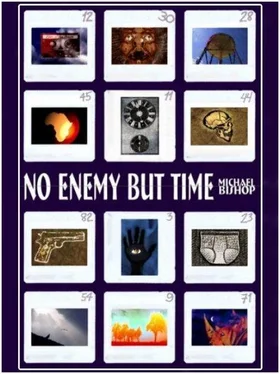


![Ally Carter - [Gallagher Girls 01] I'd Tell You I Love You But Then I'd Have to Kill You](/books/262179/ally-carter-gallagher-girls-01-i-d-tell-you-i-lo-thumb.webp)


